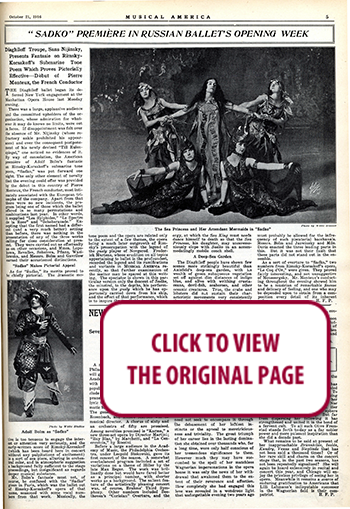 100 YEARS AGO IN MUSICAL AMERICA (165)
100 YEARS AGO IN MUSICAL AMERICA (165)
October 21, 1916
Page 5
“SADKO” PREMIERE IN RUSSIAN BALLET’S OPENING WEEK
Diaghileff Troupe, Sans Nijinsky, Presents Fantasie on RimskyKorsakoff’s Submarine Tone Poem Which Proves Pictorially Effective—Debut of Pierre Monteux, the French Conductor
THE Diaghileff ballet began its deferred New York engagement at the Manhattan Opera House last Monday evening.
There was a large, applausive audience and the committed upholders of the organization, whose admiration for whatever it may do knows no limits, were out in force. If disappointment was felt over the absence of Mr. Nijinsky (whose refractory ankle prohibited his appearance) and over the consequent postponement of his newly devised “Till Eulenspiegel,” one noticed no evidences of it. By way of consolation, the American premiere of Adolf Bolm’s fantasie on Rimsky-Korsakoff’s submarine tone poem, “Sadko,” was put forward one night. The only other element of novelty that the evening could offer was provided by the début in this country of Pierre Monteux, the French conductor, most intimately associated with the European triumphs of the company. Apart from that there were no new incidents, the program being one of those which the ballet offered in so many permutations and combinations last year. In other words, it supplied “Les Sylphides,” “Le Spectre de la Rose” and “Scheherazade.” Excepting that the first named had a different (and a very much better) setting than before, there was nothing in the presentation of any of the three works calling for close consideration at present. They were carried out as effectually as on other occasions, and Mmes. Lopokowa, Revalles, Sokolova, Pflanz, Wasiliewska, and Messrs. Bolm and Gavrilow earned their accustomed distinctions.
“Sadko” Makes Pictorial Appeal
As for “Sadko,” its merits proved to be chiefly pictorial. The dramatic motive is too tenuous to engage the interest or attention very seriously, and the early-written score of Rimsky-Korsakoff (which has been heard here in concert without any palpitations of excitement) is a sort of sea piece, alluring in orchestral color, and in atmospheric suggestion a background fully sufficient to the stage proceedings, but insignificant as regards deeper musical substance.
Mr. Bolm’s fantasie must not, of course, be confused with the “Sadko” given in Paris, which was the ballet out of Rimsky-Korsakoff’s opera of that name, seasoned with some vocal numbers from that work. Musically, the tone poem and the opera are related only to the extent of a few themes, the opera being a much later outgrowth of Rimsky’s preoccupation with the legend of the gusly player of Novgorod. Frederick Martens, whose erudition on all topics appertaining to ballet is the profoundest, recorded the legend and its ramifications and variants in MUSICAL AMERICA recently, so that further examination of the matter may be spared at this writing. The spectator is shown in, this particular version only the descent of Sadko, the minstrel, to the depths, his performance upon the gusly which he has opportunely carried down from his ship, and the effect of that performance, which is to inspire the inevitable terpsichorean orgy, at which the Sea King must needs dance himself to death so that the Sea Princess, his daughter, may unceremoniously elope with Sadko in an accommodatingly mobile conch shell.
A Deep-Sea Garden
The Diaghileff people have shown few scenes more strikingly beautiful than Anisfeld’s deep-sea garden, with its wealth of green subaqueous vegetation set off against dim distances of indigo blue, and alive with writhing crustaceans, devil-fish, seahorses, and other oceanic creatures. True, the crabs and lobsters did not sustain their characteristic movements very consistently throughout the ballet, but then license must probably be allowed for the infrequency of such piscatorial bacchanals. Messrs. Bolm and Jazwinsky and Mlle. Doris enacted the three leading parts in this. But it was not their fault that these parts did not stand out in the ensemble.
As a sort of overture to “Sadko,” two numbers from Rimsky-Korsakoff’s opera, “Le Coq d’Or” were given. They proved fairly interesting, and not un-suggestive of Moussorgsky. Mr. Monteux’s conducting throughout the evening showed him to be a musician of remarkable finesse and delicacy of feeling, and one who may be depended upon to obtain from a composition every detail of its inherent value. —H. F. P.




 RENT A PHOTO
RENT A PHOTO





